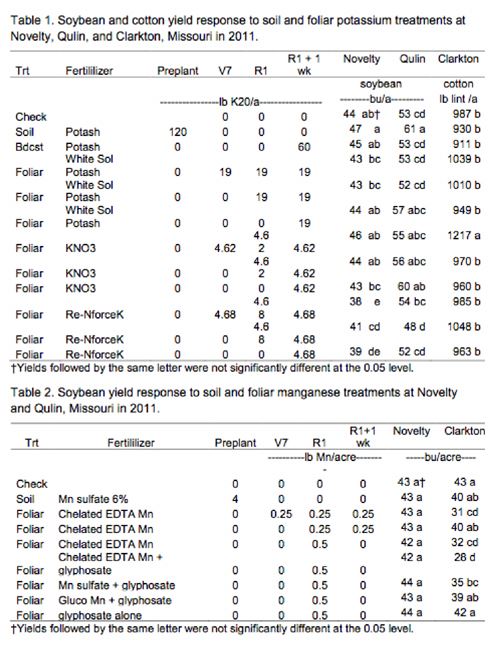In-Field Tissue Testing For Crop Nutrients
PORTAGEVILLE, MO.
Soybean and cotton farmers could benefit from rapid, inexpensive methods to evaluate crop tissue or sap to determine when mid-season foliar sprays are needed to maximize yields. Horticulture crop growers measure plant sap in tomatoes, potatoes, and lettuce as a tool for managing N. Water districts in California published leaf sap nitrate-nitrogen sufficiency guide sheets for testing fresh sap from broccoli, brussel sprouts, cabbage, cauliflower, celery, lettuce, spinach, and onions.
The objective of this study is to evaluate field ion-selective electrode meters, colorimeters, and color indicator strip tests on soybean and cotton plants growing on a range of soil test levels and foliar fertilizer N, K, and Mn applications. We hope to develop a fast testing process which works like a diabetic person pricking his finger and testing for blood sugar.
Soil samples were collected from fields at the Fisher Delta Center at Portageville, Rhodes Farm at Clarkton, Greenley Center at Novelty, and Missouri Rice Research Farm at Qulin, Missouri. Soybean and cotton was planted in small plots in fields with soil test levels in the low and medium ranges for potassium and manganese. Cotton was also planted at Clarkton to evaluate N quick tests. Fertilizer treatments for K, Mn, and N included an untreated check, recommended dry preplant fertilizer and several timings and sources of foliar fertilizer. Each treatment was replicated five times. Leaves and petioles from each soybean and cotton plot were collected. Samples were collected at V7, R1, and R1+ 1 week growth stages followed by foliar sprays of each nutrient on treatments using a CO2 backpack sprayer. Plots were visually rated for leaf burn at 3, 7, and 14 dates after foliar applications. Leaf and petiole samples were frozen in plastic bags until they could be processed. A garlic press was used to squeeze leaf and petiole sap. Cotton tissue nitrate-N was measured by Horiba ® Cardy nitrate meter, Hach® Colorimeter, and Quant ® Nitrate test Strips. Duplicate samples were oven dried and tested in the Delta Center Lab with a nitrate ion-selective electrode. A plot combine and cotton picker were used to mechanically harvest plots. Yield response to foliar spray will be correlated with leaf sap meter reading to determine best growth stages and leaf stems to sample.

A significant soybean yield increase was found at Novelty and Qulin from applying preplant potash (Table 1). In soybean plots, none of the foliar K treatments produced significant yield increases compared to the untreated check. At Novelty, significant leaf burn occurred with Re- NforceK. For cotton, most of the K treatments showed no yield increases, but three application of KNO3 did significantly increase lint yield compared to the check. No significant soybean yield increases were found from Mn soil or foliar fertilizers at Novelty or Clarkton (Table 2). Likewise, N did not increase cotton lint yields at Clarkton. This field had been used in winter legume cover crop research in the past and may have N released from organic matter during the year. We are currently in the process of making quick test measurements from frozen samples collected during the season and comparing the results to duplicate leaf and petiole samples test at the Delta Center Soil Lab. Δ
DR. GENE STEVENS: Professor Soybean Breeding, University of Missouri
MATT RHINE: Research Associate/Crop Production, University of Missouri
DR. KELLY NELSON: Research Associate Professor/ Division of Plant Sciences, University of Missouri
JIM HEISER: Research Associate/Crop Production, University of Missouri
DAVID DUNN: Supervisor/Soil Testing Laboratory, University of Missouri